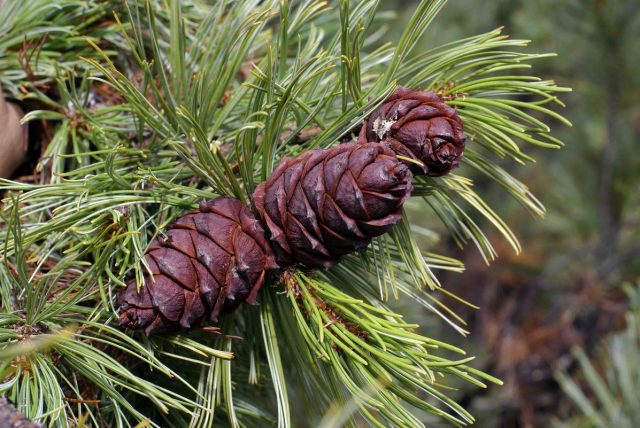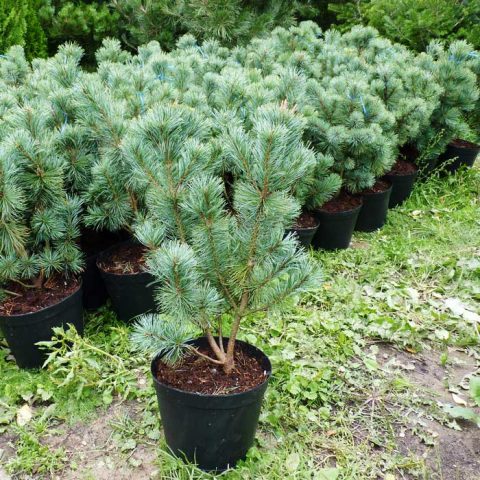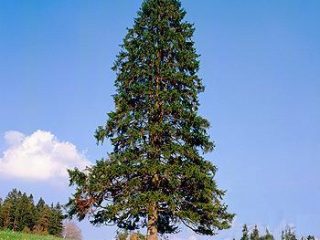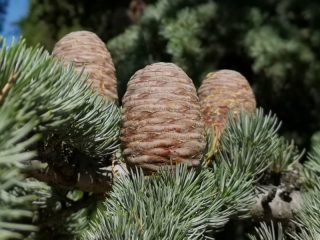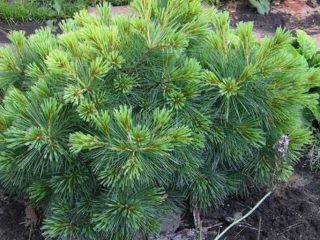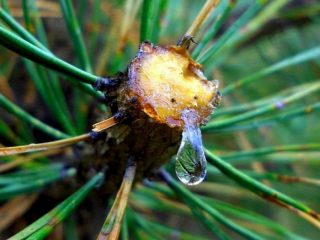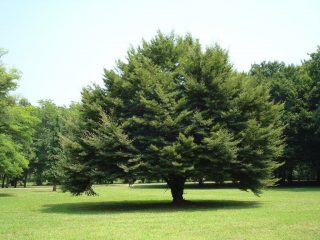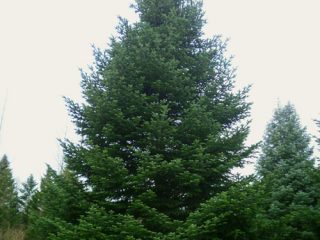Content
Dwarf cedar is one of the forms of woody plants with a varied crown. Because of its structure, elfin trees are considered a shrub, “half-bush-half-tree”. The accumulation of plants forms creeping forests.
Description of dwarf cedar
Dwarf cedar is a compact plant. A cup-shaped crown is formed by branches spread wide to the sides. The trunk is covered with dark brown bark. Light spots, slight peeling are visible on it. The branches have a gray, smooth bark. They are pressed to the earth's surface, only the ends of the branches are directed upwards. Newly growing shoots of dwarf cedar are first colored green and have dense pubescence. Over time, they turn brown.
The needles are long - up to 8 cm, have a triangular structure, gray-green color. The needles on the branches are arranged in bunches of 5 needles.
After pollination, the cones ripen only in the 2nd year. They are small, oval in shape. The length of the cones reaches 7 cm, the width is 2 times less.
Dwarf pine forms small brown oval nuts with a thin lignified skin. Walnut length - no more than 9 mm, width - up to 6 mm.
The seed production period begins in 20 or 30 years.
The root system grows in a peculiar way. First, the dwarf pine forms the main root and the lateral root system. Gradually, the central root dies. The plant develops lateral roots located on the surface. Over time, they become overgrown with a moss layer and deepen. To replace them, dwarf cedar forms adventitious roots. Branches touching the earth's surface are also capable of forming adventitious roots. The formation of a system of adventitious roots makes the tree tenacious and hardy.
The wood of the plant is dense, pricks with difficulty. It has many resin passages, a pronounced coniferous aroma.
Spread of dwarf cedar
Dwarf cedar is a representative of the woody flora, adapted to poor soils, low temperatures.
The root system is located close to the surface, therefore, permafrost does not affect the distribution of dwarf pine. Since the form of the plant is creeping, the dwarf cedar survives low winter temperatures under the snow.
The tree's growing area is extensive. It lives in the Far East and is found in Eastern Siberia. In the north, its thickets go beyond the Arctic Circle. In the south, it forms continuous thickets in mountainous areas at an altitude of 800-900 m above sea level. In open areas, it forms independent thickets, sometimes serves as the lower tier for larch forests.
Using cedar dwarf
Dwarf cedar has decorative characteristics. Due to its decorative effect, it is used for landscaping areas and settlements.
It is also appreciated for the numerous products obtained on the basis of plant parts:
- Dwarf pine nuts are a source of high quality oil. Halva, filling for sweets, cookies are prepared from the cake. Whole nuts are eaten.
- Solid wood is used to make crafts.
- Trunks, twigs, roots are used to obtain resin and turpentine.
Dwarf cedar contains many biologically active substances.Therefore, products based on it are widely used for medical purposes. Turpentine is used to treat:
- colds of the respiratory system;
- organs of excretion;
- skin diseases.
Young shoots are used to heal wounds. For a long time, young branches have been used to treat scurvy.
A dye is obtained from the needles, usually green.
In nature, dwarf cedar is used to strengthen slopes, talus. Planting along the roads.
Designers began to use the plant for landscaping and garden decoration. Dwarf cedar is suitable for decorating alpine slides, hedges. Among conifers, this plant produces the most phytoncides. These substances kill pathogens. Therefore, just being around and inhaling the ephedra scent is very beneficial. In the European part of Russia, dwarf cedar is still not widespread.
Growing cedar dwarf from seeds
Dwarf cedar can be propagated by seeds. This requires seed. It is purchased in specialized stores. If possible, you can collect the cones yourself, germinate, get sprouts, and subsequently seedlings.
For this, stratification is first carried out. That is, nuts are kept at a temperature of 2 to 5 degrees for 6 months. Then they are placed in moist soil at a distance of 2 cm. It is not necessary to cover them with soil. Moss is placed on top of the soil. It should be wet. In the future, the moss will maintain soil moisture. Seed germination is low, so it is better to plant more of them.
Planting and caring for dwarf cedar in the open field
Unpretentious to low temperatures, it reproduces and grows slowly. Requires the creation of optimal conditions.
Seedling and planting plot preparation
To place the cedar dwarf, choose the right place. In nature, the plant lives on any soil. Therefore, special preparation should not be carried out here. If the soil is purely sandy, add clay. There should be more of it than sand.
Since the roots of the cedar dwarf are shallow, and the branches are spreading, there should be a lot of planting space.
When choosing a seedling, special attention is paid to the roots. They must be whole, moist and clogged with earth. The branches should be flexible with no signs of damage. The height of the seedling is at least 15 cm.
Landing rules
Planting cedar dwarf is recommended to be carried out from April to the second half of May. With dry autumn - from late August to early September. Placing a seedling on a site involves a number of rules:
- Preparation of the landing pit. Its depth should be much greater than the height of the seedling itself - 80 cm. The width of the prepared place should be 2-3 times the size of the earthen coma. Drainage is laid in the lower part of the pit: large or small crushed stone, gravel, and other material. Sand is poured onto the drainage layer - 20 cm is enough. Then, to the edge, the pit is filled with a soil mixture: turf soil, sand, special soil.
- Before planting, it is recommended to place the root part in a 3% potassium permanganate solution for 2 hours. This procedure will prevent possible diseases.
- When filling the pit with soil mixture, pour a bucket of water. After the elfin is planted, 2 more buckets are poured. Roots must not be allowed to dry out.
- A cedar dwarf seedling is placed in a prepared place with a lump of earth. It is advisable to do all the work carefully, not to damage the roots. With the correct planting of the seedling, the root collar should be level with the ground.
- When planting several plants, leave a distance of 3-4 m between them.
- The surface of the planting pit is mulched with sawdust, pine bark, and a special material. A layer of mulch is made 8 cm.
Watering and feeding
Dwarf cedar is rarely watered. During the warm season, one bucket per month is sufficient.If the weather is hot and dry, increase watering by 1.5 times. It is recommended to spray the needles with cold water.
Mineral dressing is carried out with a special composition "NPK 15-15-15". It is a balanced fertilizer from the MINERAL line. The first feeding is performed in April. Then every month it is fertilized with a liquid humic composition of the same line. In the absence of these compositions, use a nitroammophoska at the rate of 40 g per 1 m2... Fertilizer "Kemira Universal" add 20 g per bucket of water.
Pruning
Dwarf cedar needs sanitary pruning. For this, diseased and damaged branches are promptly removed. For landscape design, excess branches are cut in the first decade of April. The cut sites are treated with garden varnish.
Preparing for winter
The dwarf tree is not afraid of harsh winters, but a little preparation for the cold season is needed. The roots are covered 8 cm with straw or peat. In areas with heavy rainfall, the crown can be affected by a lot of snow. To protect it, a pyramid-shaped frame is made from the bars, covered with any material.
Reproduction
Dwarf cedar reproduces slowly. To do this, use:
- ready-made seedlings purchased in specialized stores;
- seeds;
- layering.
If possible, you can use layering for reproduction. This method requires a mature tree. Roots are formed where the branches touch the ground. It is enough to separate part of the branch and move it to another place.
Diseases and pests
Dwarf cedar is a tree with good immunity. But some diseases and pests can still infect him:
- Hermes siberian Is a pest that feeds on tree sap, slows down its growth, and reduces decorative characteristics. Determined by white bloom on the needles. For treatment, dwarf pine is treated with insecticides. The method of microinjection into the trunk is used. Repeated treatments are carried out.
- Needle rust - a disease in which yellow formations in the form of bubbles appear on the needles. The needles of the affected tree fall off. As a treatment, timely removal of diseased branches is carried out. Elderberry is sprayed with immunostimulants, watering is combined with the introduction of micronutrients.
- Mushroom shute - affects plants that do not tolerate shade well. In spring, the needles acquire an orange-brown color with small growths of black color. Sick branches are removed. For prophylaxis in spring and autumn, a solution of Bordeaux liquid is used. In case of severe damage, the drug is treated with "Hom".
- Aphid - a pest that infects young plants. As a preventive measure, it is recommended to destroy ants, as they contribute to the appearance of aphids. Insecticides "Aktara", "Decis" and others help.
- Shield - in case of damage by a pest, brown formations of a rounded shape are noticeable on the needles and branches. Young shoots bend and die. If the number of pests is small, they are collected by hand. In case of severe damage, they are treated with solutions of the same insecticides.
Conclusion
Dwarf cedar is an evergreen coniferous tree with decorative properties. The plant does not require much maintenance. Having once planted this tree, you can decorate the site in an original and long-term way, as well as use the beneficial properties of the plant.
